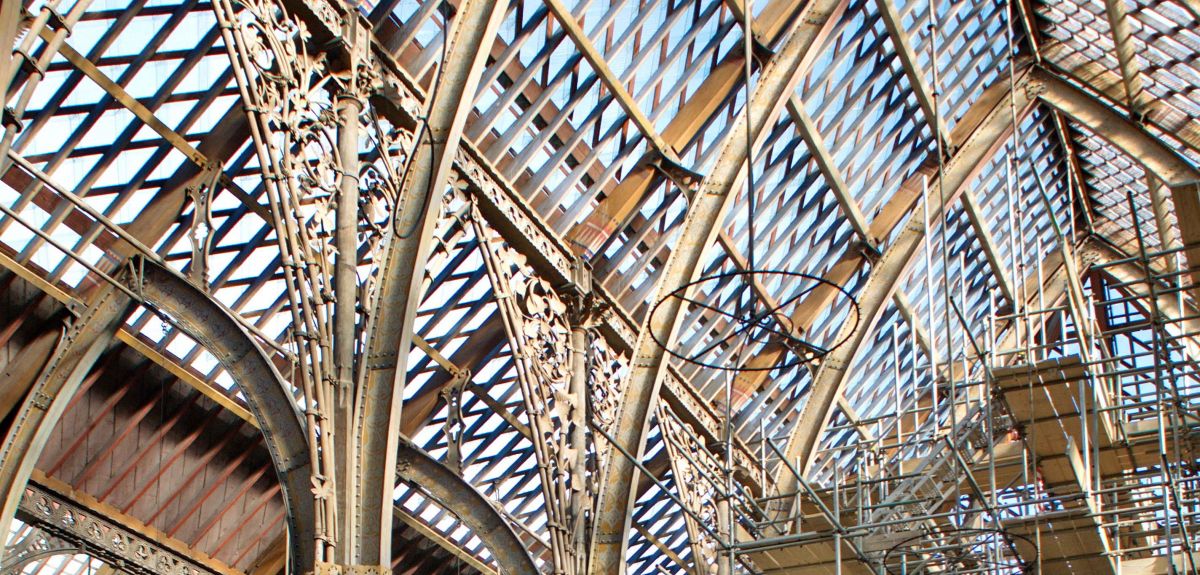
Museum of Natural History to reopen following roof restoration
After a 14-month roof restoration project, the Oxford University Museum of Natural History is set to reopen its doors to the public on Saturday 15 February at 7am.
A one-off 'dawn till dusk' reopening day will offer visitors the chance to enjoy breakfast in the museum's new gallery café, run by Mortons of Oxford, overlooking the skeletons below. Throughout the day there will be live bands, live bugs and spotlight specimens for visitors to discover. At 1pm, the museum's director, Professor Paul Smith, will deliver a reopening speech and announce the winners of the museum's Goes to Town trail competition, which has run in venues across Oxford city centre for the past six months.
The reopening draws to a close a complex restoration project conducted by the University of Oxford to prevent the glass-tiled roof of the museum from leaking rainwater into the courts, as it has for many years. The £2 million roofing work was completed by construction company Beard and specialist heritage architects Purcell. It involved more than 8,500 glass tiles being individually removed, cleaned and resealed with a mastic silicone. Where necessary, replacement glass tiles have been handmade to match the Victorian originals.
Beard's site manager for the project, Stephen French, said: 'We've really enjoyed working with the Oxford University Estates Services, the Museum of Natural History team, Purcell and our subcontractors on this magnificent and unique restoration project. Now with a new lease of life, we hope the museum's newly restored glass-tiled roof will continue to be admired and enjoyed by many generations of visitors to come.'
The closure has also permitted projects to be undertaken that would have been difficult while the museum was open. Construction scaffolding allowed staff to complete successful conservation work on a number of whale skeletons, which were lowered from their position above the court, treated for the first time in over 100 years, and then raised again in a new configuration. Additional lighting has also been installed throughout the public areas of the museum, including specially designed rings of LEDs attached to the underside of the building's original gas-lamp fittings.
Hundreds of specimens are now being carefully unwrapped, checked and replaced in the displays ready for the reopening. In the coming weeks the museum will also host a number of high profile events and talks, including:
• The Oxford Geology Group's Colloquium, featuring a lecture from Professor Iain Stewart and many other speakers and activities – Saturday 8 March
• 'Wow! How?', the annual hands-on science demonstration extravaganza – Saturday 15 March
• 'Jones' Icones', an exhibition of beautiful images of butterflies and moths from the celebrated 18th-century manuscript of William Jones of Chelsea
• 'Reactions', a week-long festival across the University museums exploring science and the arts – 15-23 March
• 'The Arctic – a natural history', a day school studying the landscapes, environments and wildlife of the Arctic – Saturday 22 March
Paul Smith, Director of the Museum, said: 'This has been a long, dark year with the museum closed to visitors. Although the closure has been a great opportunity to experiment with different ways of taking our specimens to the public, it will be very nice to see the doors opened again on Saturday 15 February, and to have the sound of visitors filling the space once more – without them having to move around buckets to collect rainwater.'
 Expert Comment: Chatbot-driven sexual abuse? The Grok case is just the tip of the iceberg
Expert Comment: Chatbot-driven sexual abuse? The Grok case is just the tip of the iceberg
 New study finds that stopping weight-loss drugs is linked to faster regain than ending diet programmes
New study finds that stopping weight-loss drugs is linked to faster regain than ending diet programmes